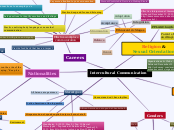Intercultural Communication
Nationalities
Nonverbal Communication
Proxemics
Chronemics
Artifactual
Color
Paralanguage
Haptics
Kinesics
olfactics
symbols
Physical Appearance
Environment
Stereotypes
Caucasians don't have rhythm
African Americans are good at basketball
All Asians are geniuses
Hispanics do not speak english very well or not at all
Native Americans like to gamble
Standberry, L. (2010, May 9). Top 10 Racial Stereotypes - Toptenz.net. Retrieved December 15, 2015, from http://www.toptenz.net/top-10-racial-stereotypes.php
Gestures
Ukraine:
If you bring flowers, make sure the number of flowers is uneven (3,5, etc.), because even numbers are brought to funerals
Traditions and customs of Ukraine. Etiquette. (2008). Retrieved December 15, 2015, from http://www.ukraine-insight.com.ua/traditions.html
Subtopic
Jamaica:
Do not begin eating until the host invites you to start.
Scottland:
In Scotland, tapping the index finger on the side of the nose multiple times implies the saying, “Keep it a secret”
Scotland Nonverbal Communication. (n.d.). Retrieved December 15, 2015, from http://acad.depauw.edu/~mkfinney/teaching/Com227/culturalportfolios/SCOTLAND/NonVerbalPage.html
Genders
Men
Avoid eye contract
Talk for status
Talkative in public
Women
Use eye contact
Talk for solidarity
Talkative in private
Presley, J. (n.d.). Jasmine K .Presley. Retrieved December 15, 2015, from https://newmedialanguage.wordpress.com/author/newmedialanuage/
Generations
Traditionalists
Born before 1943
Baby Boomers
Born 1943-1960
Generation Xers
Born 1960-1980
Millennials
Born 1980-2004
Religion & Sexual Orientation
PFLAG Church
Parents, Families, and Friends of Lesbians and Gays
Clubs and Organizations
for Sexual Orientation
Organizations & Clubs - Echo Magazine. (n.d.). Retrieved December 15, 2015, from http://echomag.com/main-menu/resources/organizations-clubs/
Ethnocentric Stages
Denial
Defence
Minimization
Acceptance
Adaptation
Integration
Careers
Effective workplace
communication
Provide feedback that has an impact
Recieve feedback with grace and dignity
Pay more attention to your own emotion
Observe your own reactions to an employee's communication
Practice noticing body language or nonverbal communication
Ask questions to identify emotions and feelings
Summarize and feed back what you think you heard
Practice deep and focused listening
Prevent Predictable Decision Making Errors
Effective Interpersonal Communication. (2015). Retrieved December 15, 2015, from http://humanresources.about.com/od/interpersonalcommunicatio1/
Paige Marie Burns. Intercultural Communications.
Final
